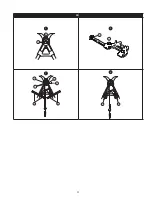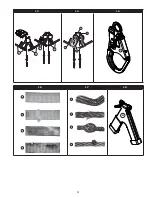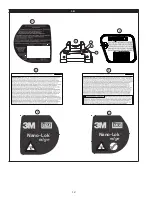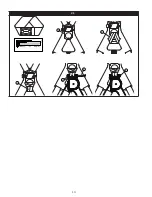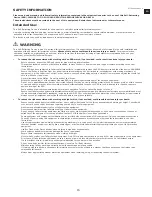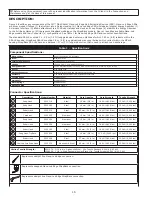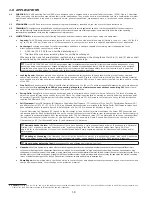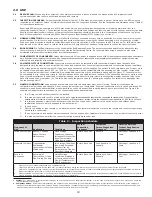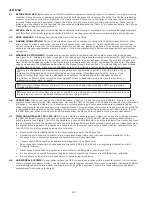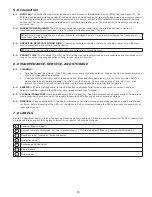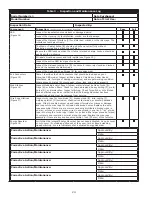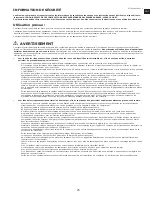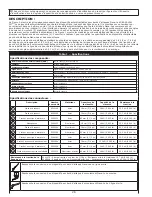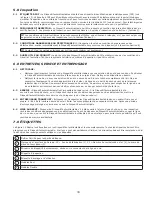
22
4.0 Use
4.1
BEFORE EACH USE:
Before each use of this fall protection equipment carefully inspect it to assure it is in good working
condition. Check for worn or damaged parts. Ensure all bolts are present and secure. Check that the lifeline is retracting
properly by pulling out the line and allowing it to slowly retract. If there is any hesitation in retraction the unit should be
removed from service and destroyed. Inspect the lifeline for cuts, frays, burns, crushing and corrosion. Check locking
action by pulling sharply on the line. See the Inspection and Maintenance Log (Table 3) for inspection details. Do not use
if inspection reveals an unsafe condition.
4.2
AFTER A FALL:
Any equipment which has been subjected to the forces of arresting a fall or exhibits damage consistent
with the effect of fall arrest forces as described in Table 3, must be removed from service immediately and destroyed.
4.3
BODY SUPPORT:
A full body harness must be worn when using SRDs.
4.4
MAKING CONNECTIONS:
Figure 11 illustrates harness and anchorage connections for SRD Fall Arrest Systems. When
using a hook to make a connection, ensure roll-out cannot occur (see Figure 5). Do not use hooks or connectors that
will not completely close over the attachment object. Do not use non-locking snap hooks. The anchorage must meet the
anchorage strength requirements stated in Section 1. Follow the manufacturer’s instructions supplied with each system
component.
4.5
WRAPBACK ATTACHMENT:
WrapBack snap hooks operate in the same manner as many conventional snap hooks.
See Figure 11-D: Gripping the hook in one hand, the index finger depresses the locking mechanism (E). With the thumb,
the gate latch is pulled back (F). As the gate latch is pulled back, the gate will open. Release the grip and the gate will
close. Wrap the WrapBack portion of the lifeline around an appropriate anchor (G), then open the gate of the WrapBack
snap hook and pass the WrapBack web portion of the lifeline through the snap hook. The lifeline may only pass through
the WrapBack hook once. Make sure the Wrapback portion of the lifeline is captured and the gate closes completely.
;
Only the WrapBack hook may be used to snap back onto the WrapBack portion of the SRD Lifeline. When
installed, the WrapBack hook must contact the heavy web section (WrapBack portion of the lifeline). If the
anchor structure is so large that the WrapBack hook contacts the lifeline above the WrapBack portion of
the lifeline, a different anchor structure must be used. Failure to heed this warning may result in equipment
malfunction, serious injury, or death.
;
A minimum setback distance of 0.6m (2 ft) is required when using Nano-Lok Edge SRDs incorporating a
WrapBack attachment.
;
Never connect the WrapBack snap hook of one SRD to the lifeline of another SRD or lanyard. Failure to heed
this warning may result in equipment malfunction, serious injury or death.
4.6 OPERATION:
Prior to use, inspect the SRD as described in Section 2.2 and the schedule in Table 2. Figure 11 shows
system connections for typical SRD applications. Connect the SRD on the back of a Full Body Harness per the instructions
in Section 3. Connect the Hook (D) or Carabiner to a suitable anchorage. Ensure connections are compatible in size,
shape, and strength. Ensure hooks are fully closed and locked. Once attached, the worker is free to move about within the
recommended working area at normal speeds. If a fall occurs the SRD will lock and arrest the fall. Upon rescue, remove
the SRD from use. When working with an SRD, always allow the lifeline to recoil back into the device under control.
4.7
TWIN SRD INTERFACE 100% TIE-OFF:
When two SRDs are mounted side-by-side on the back of a Full Body Harness,
the SRD Fall Arrest System can be used for continuous fall protection (100 % tie-off) while ascending, descending, or
moving laterally (see Figure 11B). With the Lanyard Leg of one SRD attached to an anchorage point, the worker can move
to a new location, attach the unused Lanyard Leg of the other SRD to another anchorage point, and then disconnect from
the original anchorage point. The sequence is repeated until the worker reaches the desired location. Considerations for
Twin SRD 100% tie-off applications include the following:
•
Never connect both SRD Lanyards to the same anchorage point. (See figure 12a)
•
Connecting more than one connector into a single anchorage (ring or eye) can jeopardize compatibility of the
connection due to interaction between connectors and is not recommended.
•
Connect each SRD Lanyard to a separate anchorage point. (See figure 12b)
•
Each connection location must independently support 2,248 lbs (10 kN) or be an engineered system, as with a
Horizontal Lifeline.
•
Never connect more than one person at a time to the Twin SRD system. (See figure 12c)
•
Do not allow the Lanyards to become tangled or twisted together as this may prevent them from retracting.
•
Do not allow any lanyard to pass under arms or between legs during use.
4.8
HORIZONTAL SYSTEMS:
In applications where the SRD is used in conjunction with a horizontal system (i.e. Horizontal
Lifeline, Horizontal I-Beams Trolley), the SRD and horizontal system components must be compatible. Horizontal systems
must be designed and installed under the supervision of a qualified engineer. Consult the horizontal system equipment
manufacturer’s instructions for details.
Summary of Contents for Nano-Lok Edge 3500209
Page 6: ...6 C 5 6 A B C 7 ý NO 90 90 þ OK 8 C B A A B C ...
Page 9: ...9 10 1 B A 2 C G D C 3 F F C A E D 4 F F ...
Page 10: ...10 11 A B A C B D D C C C B A F E D G 12 A B C ...
Page 11: ...11 13 14 15 E E E E xxxx xxxx xxx C D A E B A A 16 17 18 A B C D C A B D A ...
Page 12: ...12 19 A 2 1 B 3 C D E Nano Lok edge F Nano Lok edge G ...
Page 13: ...13 20 2 1 2 1 A B 2 1 2 1 C ...
Page 14: ...14 21 1 2 3 5 4 6 ...


